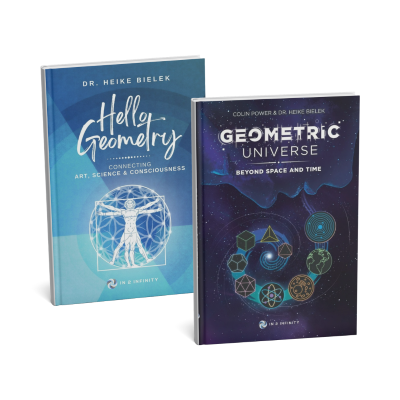Welcome, to this online guide to Euclidean Geometry, produced by In2infinity, and written by Sunil Jenkar. This series of posts covers everything you need to know about the basic tenants of Euclidean geometry. Browse through the pages or follow through step by step to gain a deeper comprehension of the mathematics and terms used in this fascinating field.
About this Guide
The Guide to Geometry provides you with everything you need to know to explore this fascinating subject. Geometry is the study of numbers in space. Alongside Arithmetic, pure number, it is one of the oldest branches of mathematics that studies the sizes, shapes, positions angles and dimensions of objects. In school, we learn geometry to measure the length, area, and volume of different 2D shapes (length and width) such as circles, triangles, squares or in 3D space (length, width & height), such as spheres & cubes. Rooted in the Quadrivium of the 7 liberal Arts of Ancient Greece, this Guide takes on Euclidean geometry.
Origins of Geometry
Geometry originates from the Ancient Greeks, which translates into ‘Geo’ meaning ‘earth’ and ‘metri’, measurement. While Euclid of Alexandria is known as the father of geometry, he was not the first person who used geometry. The earliest recorded geometric images go as far back as ancient Babylonia from around 3000 BC. The famous Pythagoras Theorem of right-angled triangles can be traced back to Ancient Egypt and Babylon 1500 years before Pythagoras and is even found in ancient scripture of India.
Waht is Geometry?
Geometry can be defined as a quantitative and qualitative study of space and forms. The most fundamental attributes about space/form include shape and size. Geometry is a deductive system. This means there is a logical development and a few simple, fundamental principles. These fundamental principles include definitions (giving meaning to terms that are to be used during the exposition of the subject like point, line, angle etc.), axioms (self-evident universal truths for e.g.: things which equal to the same thing are also equal to each other) and postulates (subject specific apparent truths granted without proof, for e.g.: To draw a straight line from any point to any point).
Types of Geometry
Plane geometry is the mathematical study of geometric figures whose parts lie in the same plane, such as lines, circle, and polygons. Plane geometry deals with objects that only have length and breadth.
A polygon is a closed figure contained by three or more lines. Polygon comes from ‘poly’ meaning many and ‘gon’ meaning corners. The simplest possible polygon is with three corners and three lines, it is called a triangle. Polygons are classified according to the number of corners or sides they are made of. Quad implies four, pent implies five and so on.
Solid geometry is the mathematical study of solid objects that occupy geometric space. Solid objects are those which are defined by height (or depth or thickness) in addition to length and breadth. Examples of solid objects include sphere (ball shape), cube (box shape), cone, cylinder etc.
Circles and sections
In geometry, conic section, also called conics, is any curve produced by the intersection of a plane and a right circular cone. Depending on the angle of the plane relative to the cone, the intersection is a circle, an ellipse, a hyperbola, or a parabola.
- Circle : If the cone is sliced parallel to the base, the resulting curve is a circle.
- Ellipse: If the cone is sliced on a slight angle, the curve is called an ellipse.
- Parabola : If the slice is made parallel to the edge of the cone, the curve formed is called a parabola.
- Hyperbola: If the slice is perpendicular to the base of the cone, the curve is one of two branches of a hyperbola.
Proportion
Proportion is the expression of equality between two equal ratios. Where ratio is defined as the comparison or simplified form of two quantities of the same kind. This relation indicates how many times one quantity is equal to the other; or in other words, ratio is a number which expresses one quantity as a fraction of the other. A ratio is an indication of the relative size of two magnitudes.
Explore More
Browse through the Guide or go to the start here.
Polyhedra – II (Cylinders and Cones)
Welcome, to this online guide to Euclidean Geometry, produced by In2infinity, and written by Sunil Jankar. In this final section
Polyhedra I (Prisms and Pyramids)
Welcome, to this online guide to Euclidean Geometry, produced by In2infinity, and written by Sunil Jankar. In this section, we
Regular and Semi-Regular Polyhedra
Welcome, to this online guide to Euclidean Geometry, produced by In2infinity, and written by Sunil Jankar. In this section, we
The Sphere
Welcome, to this online guide to Euclidean Geometry, produced by In2infinity, and written by Sunil Jankar. This section explores the

Solid Geometry
Welcome, to this online guide to Euclidean Geometry, produced by In2infinity, and written by Sunil Jankar. This section marks the
The Cuboctahedron
Sacred Geometry is defined as drawing without measurement. It involves the tools of drawing compass and ruler, but unlike traditional


